Physics
1/80
Name | Mastery | Learn | Test | Matching | Spaced |
|---|
No study sessions yet.
81 Terms
Dot Product (A * B = ?)
a · b = |a| × |b| × cos(θ)
Used to generate a scalar quantity
Cross Product (A x B = ?)
a × b = |a| |b| sin(θ) n
n = Unit Vector in plane perpendicular to a and b
SI Unit for Force
Newton (N) = (kg*m)/s²
Magnitude of the Gravitational Force (Fg = ?)
Fg = Gm1m2/r²
G = Universal Gravitational Constant = 6.67 × 10-11 (N*m²)/kg²
Static Friction (fs)
0 ≤ Fs ≤ μsN
μs is the coefficient of static friction
Exists between a stationary object and the surface upon which it rests
Kinetic Friction
Fk = μk * N
Exists between a sliding object and the surface over which the object slides
Relationship between Weight and Mass (Fg = ?)
Fg = mg
Fg = Weight of the object
g = Acceleration due to gravity = 9.8 m/s2
Center of Mass (x = , y = , z = ?)
x = (m1×1 + m2×2 + …)/ (m1 + m2 + …)
y = (m1y1 + m2y2 + …)/ (m1 + m2 + …)
z = (m1z1 + m2z2 + …)/ (m1 + m2 + …)
x-, y-, and z-values are coordinates
Newton’s First Law
A body either at rest or in motion with constant velocity will remain that way unless a net force acts upon it (Law of Inertia)
Fnet = ma = 0
Newton’s Second Law
An object of mass m will accelerate when the vector sum of the forces results in some nonzero resultant force vector
Fnet = ma
Newton’s Third Law
To every action, there is always an opposed but equal reaction
FAB = F-AB
v = ? (1-D Motion)
v = v0 + at
x = ? (1-D Motion)
x = v0t + at²/2
v² = ? (1-D Motion)
v² = v0² + 2ax
Fg (Parallel) = ?
Fg (Parallel) = mg sin(θ)
Component of gravity parallel to the plane
Fg (Perpendicular) = ?
Fg (Perpendicular) = mg * cos(θ)
Centripetal Force
Involved in circular motion; Always points radially inward; Centripetal acceleration (and all acceleration) is always in the same direction as the net force
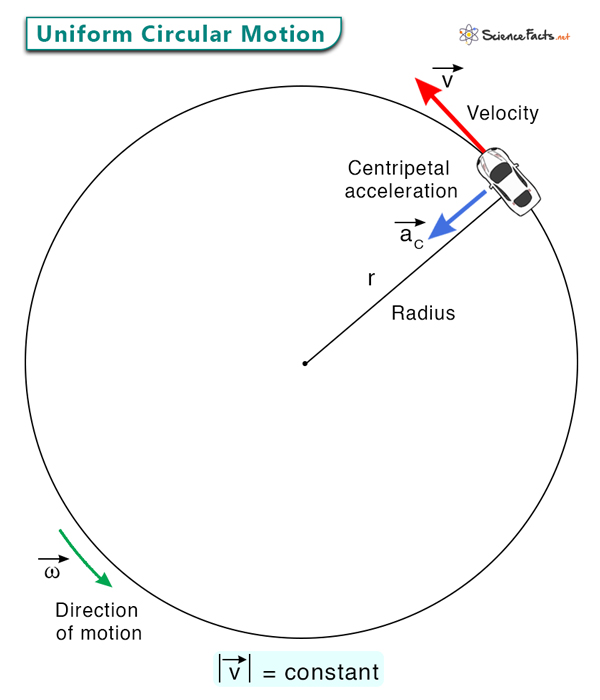
Magnitude of the Centripetal Force (Fc = ?)
Fc = mv²/r
Translational Equilibrium
Exists only when the vector sum of all of the forces acting on an object is zero; AKA First Condition of Equilibrium
Torque (Γ = ?)
Γ = r × F = rFsin(θ)
r = Length of the lever arm
F = Magnitude of the force
Γ = - = Clockwise rotation
Γ = + = Counterclockwise rotation
Rotational Equilibrum
Exists only when the vector sum of all the torques acting on an object is zero; AKA Second Condition of Equilibrium
Kinetic Energy (K = ?)
K = ½ * mv²
Gravitational Potential Energy (U = ?)
U = mgh
Elastic Potential Energy (U = ?)
U = ½ * kx²
k = Spring constant
x = Magnitude of displacement from equilibrium
Total Mechanical Energy (E = ?)
E = U + K
Conservative Forces
Forces that are path independent and that do not dissipate energy; Ex. Gravitational and electrostatic
Nonconservative Forces
When these forces are present, total mechanical energy is not conserved; Ex. Friction, air resistance, or viscous drag
Work (W = ?)
W = F * d = Fdcos(θ)
When something exerts forces on or against something else
Isobaric Work (W = ?)
W = P * ΔV
Power (P = ?)
P = W/t = ΔE/t
The rate at which energy is transferred from one system to another
Work-Energy Theorem (Wnet = ?)
Wnet = ΔK
The net work done by forces acting on an object will result in an equal change in the object’s KE
Mechanical Advantage (= ?)
Mechanical Advantage = Fout/Fin
The ratio of magnitudes of the forces exerted on an object by a simple machine (Fout) to the force actually on the simple machine (Fin)
Efficiency (= ?)
Efficiency = Wout/Win = (load * load distance)/(effort * effort distance)
Use with pulleys
Kelvin to Celsius
K = C + 273
Fahrenheit to Celsius
F = (9/5 * C) + 32
Linear Expansion (ΔL = ?)
ΔL = αL∆T
Volumetric Expansion (∆V = ?)
∆V = βV∆T
β = 3α
Isolated Systems
Not capable of exchanging energy or matter with their surroundings
Closed Systems
Capable of exchanging energy, but not matter
Open Systems
Can exchange both matter and energy
State Functions
Independent of the path taken to get to a particular equilibrium state; Pressure, density, temperature, volume, enthalpy, internal energy, Gibbs free energy, entropy
Process Functions
Describe the path taken to get from one state to another; Work and heat
Change in Internal Energy (∆U = ?)
∆U = Q - W
Isothermal: ∆U = 0, Q = W
Adiabatic: Q = 0, ∆U = -W
Isovolumetric: W = 0, ∆U = Q
Heat (q = ?)
q = mc∆T
q = mL
L = Heat of transformation (phase change)
+ = Heat flows into system
- = Heat flows out of system
Conduction
Direct transfer of energy from molecule to molecule through molecular collisions; Must have direct physical contact between the objects
Convection
Transfer of heat by the physical motion of a fluid over a material; Only liquids and gases can transfer heat by this means
Radiation
Transfer of energy by electromagnetic waves
Change in Entropy (∆S = ?)
∆S = Qrev/T
Qrev = Heat gained or lost in a reversible process
Reversible Process
When the net change in the entropy of the system and its surroundings is zero; Process must go so slowly that the system is always in equilibrium and no energy is lost or dissipated
Weight from Density (Fg = ?)
Fg = ρVg
Specific Gravity (SG = ?)
SG = ρ/(1 g/cm3)
Pressure (P = ?)
P = F/A
Unit: Pa [1 Pa = 1 N/m2]
Absolute (Hydrostatic) Pressure (P = ?)
P = P0 + ρgz
P = Absolute pressure
P0 = Incident pressure, pressure at the surface
Total pressure that is exerted on an object that is submerged in a fluid
Gauge Pressure (Pgauge = ?)
Pgauge = P - Patm = (P0 + ρgz) - Patm
The difference between the absolute pressure inside the tire and the atmospheric pressure outside the tire
Pascal’s Principle (P = ?) (F2 = ?)
P = F1/F2 = F2/A2
F2 = F1 * (A2/A1)
As A2 is larger than A1 by some factor, the magnitude of the force, F2, exerted against A2 must be greater than F1 by the same factor so that P1 = P2
For fluids that are incompressible, a change in pressure will be transmitted undiminished to every portion of the fluid and to the walls of the containing vessel
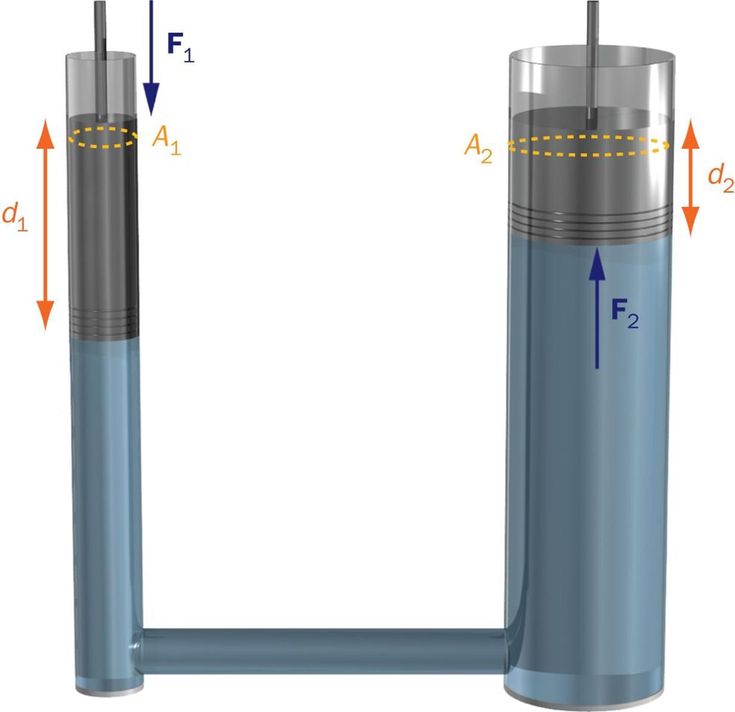
Buoyant Force
Fbuoy = ρfluidVfluid displacedg = ρfluidVsubmergedg
If two objects placed in a fluid displace the same volume of fluid, they will experience the same magnitude of buoyant force even if the objects themselves have different masses
An object will float, no matter what it is made of and no matter how much mass it has, if its average density is less than or equal to the density of the fluid into which it is placed
Viscosity (η)
The resistance of a fluid to flow
Unit: Pascal-second [Pa * s = N * s/m²]
Pouiseuille’s Law (Q = ?)
Q = (πr4∆P)/8ηL)
Q = Flow rate
r = Radius of the tube
∆P = Pressure gradient
η = Viscosity of the fluid
L = Length of the pipe
Critical Speed (vc = ?)
vc = NRη/ρD
NR = Reynolds number
In unobstructed fluid flow, turbulence can arise when the speed of the fluid exceeds this
Linear Speed (Q = ?)
A measure of the linear displacement of fluid particles in a given amount of time; While flow rate is constant, ______ of the fluid does change relative to the cross-sectional area
Q = v1A1 = v2A2
Continuity Equation: Shows that fluids will flow more quickly through narrow passages and more slowly through wider ones
Bernoulli’s Equation
P1 + (1/2)ρv12 + ρgh1 = P2 + (1/2)ρv22 + ρgh2
h = height of the fluid above some datum
More energy dedicated toward fluid movement means less energy dedicated toward static fluid pressure, and vice versa
Venturi Effect
With lower absolute pressure, the column of fluid sticking up from the Venturi tube will be lower and point 2; As the tube narrows, the linear speed increases at point 2. Thus, the pressure exerted on the walls decreases, causing the column above the tube to have a lower height at point 2.
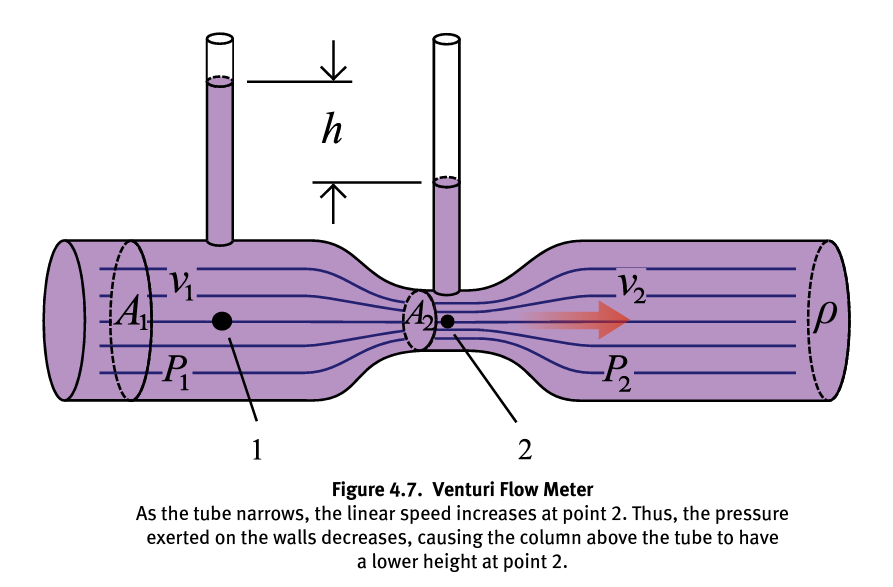
Circulatory system
A closed loop that has a nonconstant flow rate that can be measured as a pulse
Blood volume entering the heart is always equal to blood volume leaving the heart during a single cycle
As blood flows away from the heart, each vessel has a progressively higher resistance until the capillaries; however, the total resistance of the system decreases because the increased number of vessels are in parallel with each other
Return flow to the heart is facilitated by mechanical squeezing of the skeletal muscles, which increases pressure in the limbs and pushes blood to the heart, and the expansion of the heart, which increases pressure in the limbs and pushes blood to the heart, and the expansion of the heart, which decreases pressure in the heart and pulls blood in
Venous circulation holds approximately three times as much blood as arterial circulation
Charge
Unit: Coulomb, e = 1.60 × 10-19 C
Insulator
Will not easily distribute a charge over its surface and will not transfer that charge to another neutral object very well
Conductor
If given a charge, the charges will distribute approximately evenly upon the surface of the ____; Able to transfer and transport charges
Coulomb’s Law (Fe = ?)
Fe = kq1q2/r²
k = Coulomb’s Constant
Quantifies the magnitude of the electrostatic force Fe
Magnitude of an Electric Field (E = ?)
E = Fe/q = kQ/r²
Fe = The magnitude of the force felt by the test charge 1
Q = Source charge magnitude
Electric Potential Energy (U = ?)
U = kQq/r
∆U = W
Electric Potential (V = ?)
V = U/q = kQ/r
Potential Difference (Voltage) (∆V = ?)
∆V = Vb - Va = Wab/q
Wab = Work needed to move a test charge q through an electric field from point a to point b. For a positive test charge, this means moving from a position of higher electric potential to a position of lower electric potential. A negative test charge will spontaneously move from a position of lower electric potential to a position of higher electric potential.
Positive charges will spontaneously move in the direction that decreases their electric potential (negative voltage), whereas negative charges will spontaneously move in the direction that increases their electric potential (positive voltage)—yet, in both cases, the electric potential energy is decreasing.
Equipotential Line
A line on which the potential at every point is the same. That is, the potential difference between any two points on an equipotential line is zero. No work is done when moving a test charge q from one point on an equipotential line to another.

Electric Dipole (V = ?)
V = (kqd/r²)cosθ
Results from two equal and opposite charges being separated a small distance d from each other, can be transient or permanent
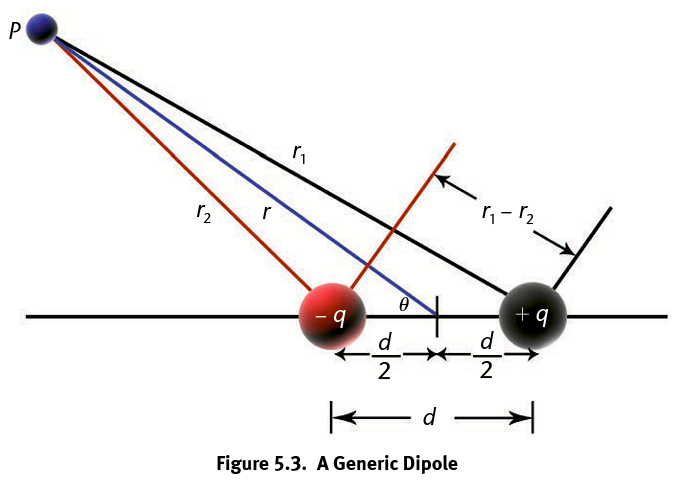
Dipole Moment (p = ?)
p = qd
The product of charge and separation distance
Units: C * m
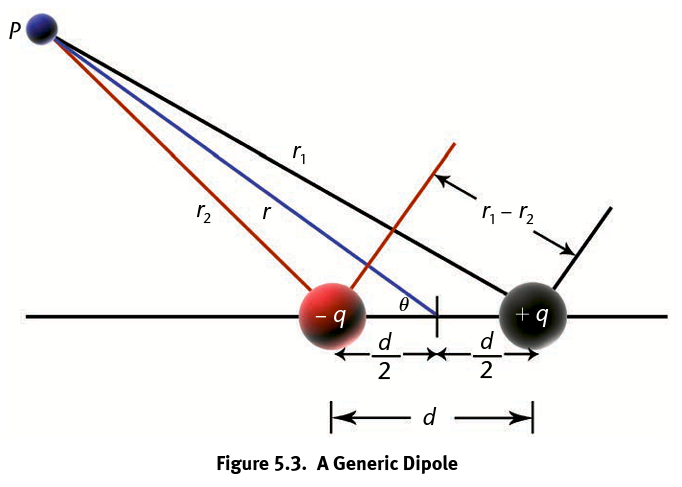
Perpendicular Bisector of the Dipole (E = ?)
E = (1/(4π∈0)) * p/r3
The plane that lies halfway between +q and -q. Because the angle between this plane and the dipole axis is 90° (and cos 90° = 0), the electric potential at any point along this plane is 0. The electric field vectors at the points along the _______ will point in the direction opposite to p.
Net Torque on a Dipole (τ = ?)
τ = pEsinθ
p = Magnitude of the dipole moment (p = qd)
E = magnitude of the uniform external electric field
θ = Angle the dipole moment makes with the electric field
Diamagnetic Materials
Made of atoms with no unpaired electrons and that have no net magnetic field; Slightly repelled by a magnet and so can be called weakly antimagnetic
Paramagnetic Materials
Has unpaired electrons and a net magnetic dipole moment; Will become weakly magnetized in the presence of an external magnetic field, aligning the magnetic dipoles of the material with the external field
Ferromagnetic Materials
Have unpaired electrons, so these atoms do have a net magnetic dipole moment; Have permanent atomic magnetic dipoles that are normally oriented randomly so that the material has no net magnetic dipole; Become strongly magnetized when exposed to a magnetic field or under certain temperatures
Magnitude of the Magnetic Field (B = ?)
B = μ0I/2πr
Magnitude of the magnetic field produced by the current I in the wire at a perpendicular distance, r, from the wire
μ0 = Permeability of Free Space
B = μ0I/2r
Magnitude of the magnetic field at the center of a circular loop of current-carrying wire of radius r
Magnetic Force (FB = ?)
FB = qvBsinθ
FB = ILBsinθ
Magnitude of the force created by an external magnetic field where I is the current, L is the length of the wire in the field, B is the magnitude of the magnetic field, and θ is the angle between L and B